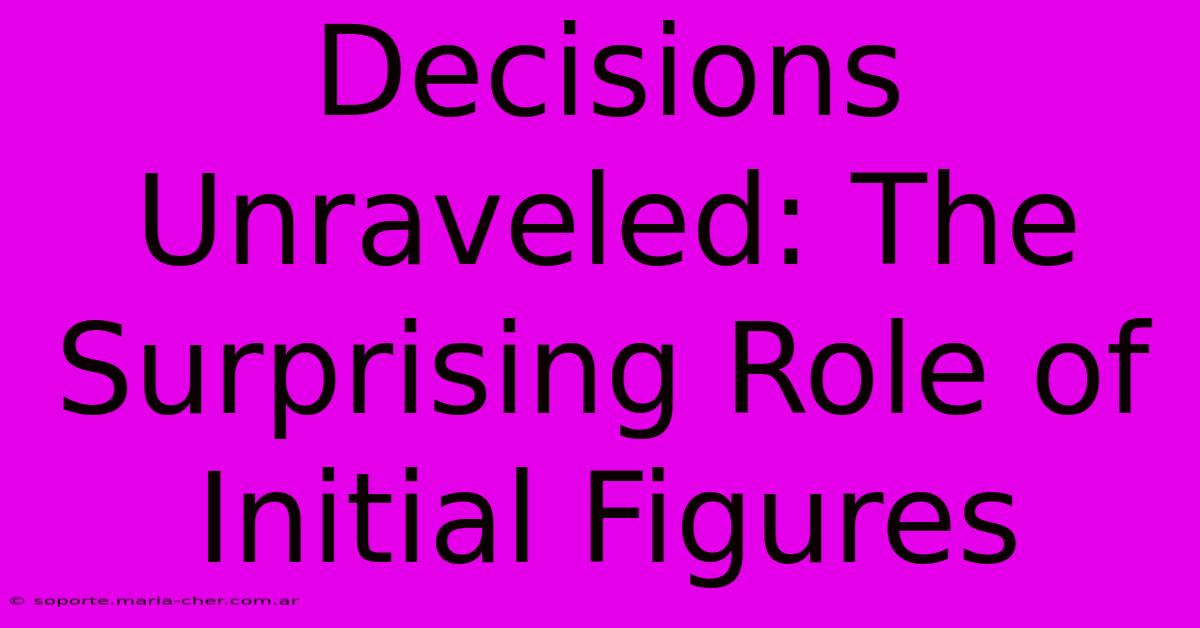Decisions Unraveled: The Surprising Role Of Initial Figures

Table of Contents
Decisions Unraveled: The Surprising Role of Initial Figures
We make decisions every day, from choosing what to eat for breakfast to selecting a life partner. While we often believe these choices are based on careful consideration and rational thought, the reality is far more nuanced. A surprising factor significantly influences our decisions: initial figures. This seemingly minor detail can subtly, yet powerfully, shape our choices, often without our conscious awareness. Understanding the impact of initial figures is crucial to making better, more informed decisions in all aspects of life.
The Anchoring Bias: The Silent Influence
The phenomenon behind the power of initial figures is known as the anchoring bias. This cognitive bias describes our tendency to rely too heavily on the first piece of information we receive (the "anchor") when making subsequent judgments. Even when the anchor is completely arbitrary or irrelevant, it can significantly sway our final decision.
Examples of Anchoring Bias in Action:
- Negotiations: A seller who initially proposes a high price will often achieve a higher final price than one who starts with a lower offer, even if the final price is still below the initial asking price. The high initial figure anchors the buyer's perception of value.
- Retail Pricing: Retailers often use this technique by presenting a higher "original price" crossed out, making the discounted price seem like a much better deal than it actually is. The original price acts as the anchor.
- Estimating Values: When asked to estimate a quantity, such as the number of jellybeans in a jar, people's guesses will be influenced by a number mentioned beforehand, even if that number is unrelated to the actual quantity.
How Initial Figures Manipulate Our Perceptions
The anchoring bias works because our brains are wired to seek efficiency. Once we have an anchor, we adjust our thinking from that point. This adjustment, however, is often insufficient, leading us to undervalue or overvalue options depending on the initial figure presented.
- Insufficient Adjustment: We don't always adjust enough from the anchor, leading to decisions based on a flawed starting point. This is particularly true under time pressure or when cognitive resources are limited.
- Confirmation Bias: Once we have an anchor, we might unconsciously seek out information that confirms our initial judgment, further reinforcing the bias.
- Emotional Impact: Initial figures can evoke an emotional response, influencing our decision-making beyond pure logic. A seemingly high price might make us feel hesitant, while a low price might trigger impulsivity.
Overcoming the Anchoring Bias: Strategies for Better Decisions
While the anchoring bias is a powerful force, we can learn to mitigate its effects and make more rational choices. Here are some practical strategies:
- Awareness: The first step is recognizing that the anchoring bias exists and that it can influence your judgments. Being mindful of this bias is the crucial first step.
- Seek Multiple Perspectives: Before making a decision, actively seek out diverse opinions and information. This will help counter the influence of any single anchor.
- Question the Anchor: Don't automatically accept the initial figure you encounter. Actively question its validity and relevance.
- Use Objective Criteria: Base your decision on objective facts and data rather than letting initial figures sway your judgment.
- Take Your Time: Avoid rushed decisions. Give yourself ample time to carefully consider all options before committing to a choice.
Conclusion: Mastering the Art of Decision Making
Understanding the subtle power of initial figures is a significant step toward improving your decision-making capabilities. By recognizing the anchoring bias and implementing effective countermeasures, you can break free from its influence and make choices that are more rational, informed, and aligned with your true goals. The journey towards better decision-making is a continuous process of learning and self-improvement, and mastering the art of recognizing and overcoming anchoring bias is a critical component of that journey. So next time you’re faced with a choice, remember the surprising role of those initial figures and strive to make decisions based on a stronger foundation of unbiased information.

Thank you for visiting our website wich cover about Decisions Unraveled: The Surprising Role Of Initial Figures. We hope the information provided has been useful to you. Feel free to contact us if you have any questions or need further assistance. See you next time and dont miss to bookmark.
Featured Posts
-
Anchoring Effect Demystified How Numbers Hold Your Judgment Hostage
Feb 12, 2025
-
The Cognitive Illusion Why We Re Slaves To Early Estimates
Feb 12, 2025
-
The Illusion Of Information How Numbers Limit Your Decision Making Horizons
Feb 12, 2025
-
Decisions Unraveled The Surprising Role Of Initial Figures
Feb 12, 2025
-
City 2 3 Real Victoire Madrilene
Feb 12, 2025
